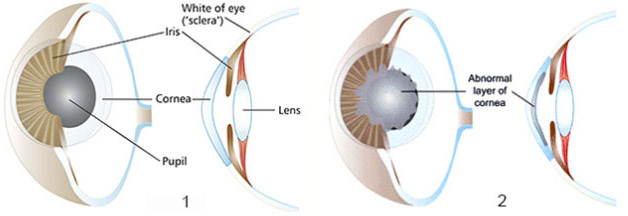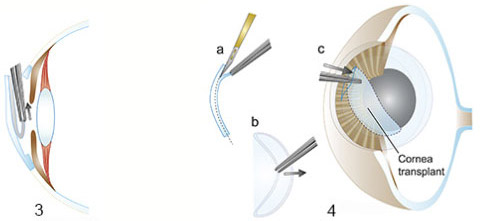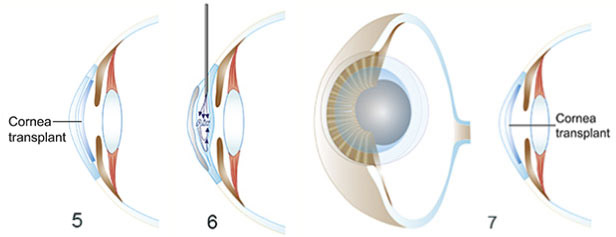I specialise in cornea surgery and did the first no-suture cornea transplant in the UK in 2003 – for a lady with Fuchs. This article explains how I perform modern partial cornea transplantation for Fuchs and how this has greatly improved the outcome of treatment.
What is Fuchs?
Fuchs Endothelial Dystrophy (Fuchs) is a disease of the cornea named after the German ophthalmologist who first described it about a century ago. The cornea is the transparent ‘front window’ of the eye.
It is important because it is the main focusing structure of the eye and so any change in its shape or transparency will reduce vision. The cornea is composed of several layers the innermost of which, called the ‘endothelium’, is needed to keep the cornea transparent by constantly removing fluid from it.
In Fuchs’ the cells of the corneal endothelium are gradually lost, a process which usually takes many years. Unfortunately the process may be speeded up after cataract surgery. The patient notices gradually worsening vision, usually in both eyes. Vision may be worse in the mornings, improving as the day progresses. Eye pain and redness only occur at a very late stage in the disease.
Fuchs’ is a fairly common disorder. It usually affects both eyes and begins in later life. The cause is completely unknown. It sometimes runs in families, although this is unusual.

A fuchs cornea photographed using a camera that shows the endothelium. The stippled orange appearance is abnormal and characteristic of this disease
Partial cornea transplantation for Fuchs (‘endothelial keratoplasty’)
This is a major advance in cornea transplantation for Fuchs as it saves most of the patient’s own cornea. Only the innermost layer (called the ‘endothelium’) is replaced and the outer layer (called the ‘stroma’) is unchanged. This is logical because in Fuchs only the endothelium is diseased and needs replacement – the stroma is perfectly normal and can be left alone. The great advantage of this method is that the donor endothelium self-adheres and is not sutured (stitched) into place. There is no astigmatism, unlike the older technique of full thickness transplantation, so contact lenses are not needed after surgery. I was the first surgeon to perform the new operation in the United Kingdom. It is also done when the cornea endothelium stops working for other reasons such as herpes virus infection or damage during cataract surgery. The article below, originally written for optometrists, describes it in more detail.
New frontiers in cornea transplantation : selective transplantation of the endothelium via a no-suture, keyhole incision
The cornea is the clear ‘front window’ of the eye. It may be damaged by disease processes such as Fuchs’ corneal endothelial dystrophy or inadvertently during cataract surgery. Damage causes the cornea to become opaque and the eye blind.
The treatment for severe cornea disease is cornea transplantation – the patient’s cloudy cornea is removed and replaced by a clear cornea obtained from a deceased person, a process similar to kidney and heart transplantation. For decades the technique used has been ‘full thickness’ cornea transplantation. This entails the removal of the entire cornea and its replacement by a transplant. Whilst traditional, full thickness cornea transplantation may successfully restore vision, it may also cause complications. These include severe astigmatism (distortion of the focus of the eye, necessitating the wearing of hard contact lenses after the operation), glaucoma (raised pressure inside the eye) and rejection of the transplant (necessitating another operation to replace it). Full thickness cornea transplantation is also undesirable because it requires virtually the entire front of the patients’ eye to be removed and replaced by the transplant – such large scale surgery may be very traumatic to this delicate organ.
Recently, a remarkable new treatment for cornea disease has become available. This is a revolutionary method of cornea transplantation called ‘selective endothelial transplantation’. The ‘endothelium’ is the layer of the cornea which is on the inside of the eye. Many cornea diseases damage only the endothelial layer, the other regions of the cornea remaining clear. Fuchs’ corneal endothelial dystrophy and damage occurring during cataract surgery are examples. Using the new technique only the diseased endothelium is replaced leaving the remainder of the cornea, which is healthy, in place.
Selective corneal endothelial transplantation is performed through a minute incision on the surface of the eye, only about 4 mm wide. This is approximately the same size as the incision made during cataract surgery. The diseased inner layer is removed through this tiny incision. A transplant composed of healthy corneal endothelium is inserted by gently folding it so that it can enter through the incision. Once inside the eye it is carefully manipulated into position and will miraculously adhere to the patient’s own cornea without sutures!
The new technique is greatly superior to traditional, full thickness cornea transplantation. The tiny incision causes much less trauma to the delicate eye. Disabling post-operative astigmatism is eliminated altogether, no sutures are required and recovery after the operation is much faster.
Case study: A 78 year old lady suffers from Fuchs’ corneal endothelial dystrophy. Her right eye received a full thickness cornea transplant several years previously. Sixteen sutures were required to secure the transplant in place. It was 18 months before healing was complete. She can only see from her right eye whilst wearing a hard contact lens which must be inserted every morning and removed before bed.
By contrast her left eye received a selective corneal endothelial transplant a few months ago. Recovery was complete after three months, no sutures were needed and she sees well from her left eye without needing to wear a contact lens.
These illustrations of partial cornea transplantation (‘endothelial keratoplasty’) should be understood as a general guide to the surgery, rather than an exact description.

1. In health, the cornea is perfectly clear
2. The technique is suitable when fuchs has famaged the inner cornea layer, the endolithium

3. The diseased endothelium us removed, leaving the rest of the cornea which is normal
4. A normal cornea will be transplanted into the patient. 4(1) Healthy endothelium is obtained from the donor cornea to match the diseased region the has been removed from the patients cornea. The transplant 4(b) folded and 4(c) inserted into the patients eye via a small incision in the cornea.

5. After insertion, the transplant is unfolded.
6. Air is injected to position the transplant against the patient’s cornea. Once contact is achived, the transplant will adhere permanently.
7. Post-operative appearance of the cornea transplant (blue region). Sutures are not required to hold the transplant in place.

An opaque cornea prior to selective corneal endothelial transplantation (left). A patient with fuchs after selective endothelial transplantation (right). The cornea is crystal clear.





